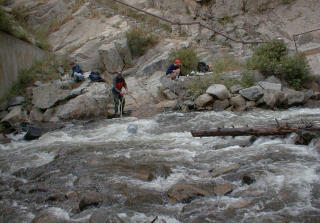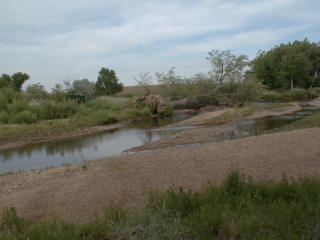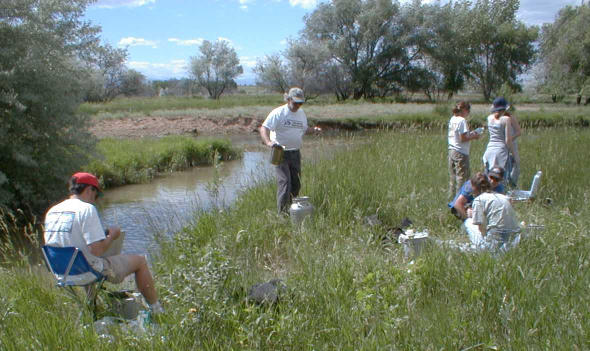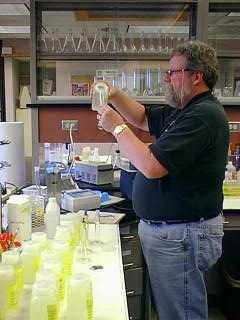
|
||
|
Boulder Creek Watershed BOULDER CREEK MILLENNIUM BASELINE STUDY | ||
BASIN - U.S. GEOLOGICAL SURVEY - CITY OF BOULDER
 What did we find out from the high-flow (June) event?
What did we find out from the high-flow (June) event?
What parameters were measured?
View the high flow data
View a map of the sampling sites
 What did we find out from the high-flow (June) event?
What did we find out from the high-flow (June) event?What parameters were measured?
View the high flow data
View a map of the sampling sites
The Boulder Creek Millennium Baseline Study, performed during the summer and fall of 2000 by BASIN, the U.S. Geological Survey, and the City of Boulder, is providing an in-depth analysis of Boulder Creek water quality. This study is sampling for several parameters not normally regulated or considered to be problematic in Boulder Creek but which will assist scientists in the Boulder community to formulate a conceptual model of the processes at work in the creek system. High-flow (June) and low-flow (October) water quality sampling of Boulder Creek from upstream of the town of Eldora to the confluence with the St. Vrain River has been carried out to determine natural and human influences on water chemistry. The study will also provide a baseline data set for the new millenium from which future water quality changes can be observed. The specific sites are listed on the map of the sampling sites. This study will focus on pesticides and heavy metals in the creek.

Stream chemistry is controlled by natural and anthropogenic (human) inputs, as well as chemical reactions that influence the fate and transport of these inputs. Detailed water quality sampling of Boulder Creek, including the main stem and major tributaries, will allow us to determine the sources and sinks of chemical constituents. The relative importance of different sources is likely to vary seasonally, and therefore high- and low-flow sampling is an important step in characterizing the watershed.
A variety of measurements will be performed on the water samples, including pH, dissolved oxygen, and major element, nutrient, metal, pesticide and pharmaceutical concentrations. See the full list of analyses that will be performed.
This study will provide information on current water quality conditions, as well as provide a baseline for future water quality surveys. In addition, the BCMB results will be compared to a 1977 study of Boulder Creek by a University of Colorado graduate student (Charles Patterson) to try to evaluate water quality changes over the past twenty years.
Schedule:
- 6/00 - high-flow samples collected concurrent with COB sampling
- 7/00 - high-flow samples analyzed, compiled, and distributed to participants.
- 9/00 - high-flow data and analysis reported on the BASIN website
- 10/00 - collect low-flow samples, concurrent with city sampling
- 11/00 - analyze low-flow samples, compile data
- 12/00- report low-flow data on BASIN website
High-Flow Sampling Event:
High-flow sampling was carried out on June 12, 13, and 14, 2000. Despite very high temperatures, hordes of mosquitoes, and a snake or two, sampling went well, thanks to USGS and City of Boulder personnel and several volunteers.

The event was organized by:
Dr. Larry Barber, Geochemist, USGS
Sheila Murphy, Research Analyst, BASIN and City of Boulder
Dr. Philip Verplanck, Hydrologist, USGS
They were assisted by many people:
Dr. Jim Ball, Research Chemist, USGS
Sherri Duren, Pretreatment Field Specialist, City of Boulder
Jenny Flynn, Environmental Engineer, USGS- Colorado District
Eileen Gardner, University of Colorado Graduate Student, volunteer
Scott Gillespie, Water Quality Technician, City of Boulder
Kelly Ann Grasmic, University of Colorado Mountain Research Station Student, volunteer
Steffanie Keefe, Hydrologist, USGS
Kurt Keilbach, Water Quality Analyst, City of Boulder
Dr. Dan Kile, Research Chemist, USGS
R. Blaine McCleskey, Chemist, USGS
Matthew Miller, University of Colorado Mountain Research Station Student, volunteer
Dr. Mark Sandstrom, Research Chemist, USGS
Jim Shelley, Water Quality Analyst, City of Boulder
Jim Stout, Stormwater Field Specialist, City of Boulder
Many other people are also contributing to the project, behind the scenes. These people include:
 Rick Dingeman, Water Quality Analyst, City of Boulder
Laura Hubbard, Chemist, USGS
Rick Dingeman, Water Quality Analyst, City of Boulder
Laura Hubbard, Chemist, USGSVicki Jones, Instrument Analyst, City of Boulder
Ed Mead, Waste Water Quality Laboratory Supervisor, City of Boulder
Dr. D. Kirk Nordstrom, Geochemist, USGS
Dr. Dave Roth, Chemist, USGS
Chris Rudkin, Water Quality Coordinator, City of Boulder
Dr. Bob Stallard, Hydrologist, USGS
Dr. Howard Taylor, Research Chemist, USGS
Jim Waterman, BASIN IMS Coodinator, enfo.com
High-Flow Sampling Results:
The results of the first sampling event have been posted in the BASIN Environmental Data Catalog.
The specific sampling sites included in this study are listed on the the BCMB imagemap catalog. A full list of the constituents tested is available from the analysis catalog.
If you have any questions and comments about the Boulder Creek Millennium Baseline Study please email the BASIN team (at basin@basin.org or through the BASIN comment form).INVITATION BASIN is a community project actively seeking public participation. We appreciate all feedback and welcome comments, suggestions and contributions. To find out more about how you can be involved, click here. Help BASIN serve your needs, take our "10 questions in 10 seconds" survey.